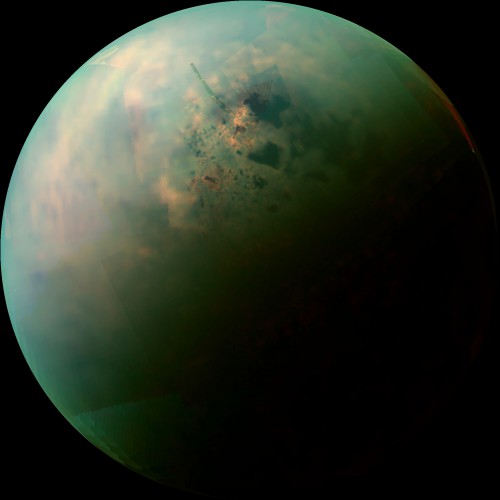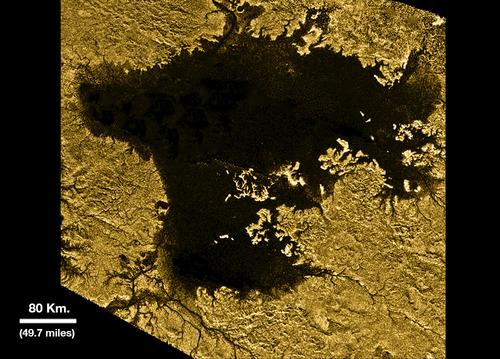
The mystery of an unusual feature in one of Titan’s hydrocarbon seas, dubbed the “mystery island,” has taken an interesting turn. After apparently disappearing following its initial discovery in 2013, it has now reappeared and has changed in appearance and size, as well.
The oddity, first seen by the Cassini spacecraft in July 2013, is in Ligeia Mare, one of the largest seas on Titan. In radar images (to see through Titan’s thick haze which envelops the moon), it appeared island-like, just off one of the coastlines of the sea. Previously, no such features had been seen in that area during earlier flybys of the moon. What it was and how it appeared was a puzzle, but then the mystery deepened when it disappeared again from subsequent images taken later on.

For several months after, Cassini scientists looked for it with no success. Whatever it was, it seemed to be transient in nature. Theories abounded, including surface waves, rising bubbles, floating solids, solids suspended just below the surface, or maybe even something else not yet thought of. It has been theorized that there may be “icebergs” of frozen methane bobbing around in Titan’s seas, much like icebergs on Earth.
And then, to everyone’s surprise, the feature reappeared in radar images taken in August 2014. It’s appearance had also changed; this time it looked less bright, but larger than before. It grew from about 30 square miles (75 square kilometers) to about 60 square miles (160 square kilometers). It had the appearance of an island, but why it would appear, disappear, and then reappear again was a puzzle.
As far as what it’s not, scientists are confident that it is not an imaging artifact or flaw in the data. Evaporation in the sea also doesn’t seem to be involved, since the nearby shoreline of Ligeia Mare has not changed noticeably in appearance.
“Science loves a mystery, and with this enigmatic feature, we have a thrilling example of ongoing change on Titan,” said Stephen Wall, the deputy team lead of Cassini’s radar team at NASA’s Jet Propulsion Laboratory in Pasadena, Calif. “We’re hopeful that we’ll be able to continue watching the changes unfold and gain insights about what’s going on in that alien sea.”

It’s fun to speculate what might be happening in this alien sea. Since it, like the other seas and lakes, is composed of liquid methane and ethane instead of water, there might be some interesting chemistry going on that is different from anything seen on Earth. It is suggested that the changes seen with “mystery island” may have a connection somehow to the changing seasons on Titan.
This mystery phenomenon also shows again how Titan is an active and dynamic world, which was already known from its alien yet Earth-like “hydrological cycle” (substituting liquid methane for water) of rain, rivers, lakes, and seas. There may even be waves on those seas, as also discussed previously on AmericaSpace. There is also thought to be an underground ocean of liquid water, similar to those on Europa and Enceladus and possibly other moons as well.
Cassini will continue to monitor any changes to the “mystery island” during its extended mission. Will it disappear again? Or continue to grow? Only time will tell, and hopefully Cassini can provide more clues to this fascinating little mystery.
Want to keep up-to-date with all things space? Be sure to “Like” AmericaSpace on Facebook and follow us on Twitter: @AmericaSpace




The combination of the totally alien environment, the coarse resolution of the Cassini radar images coupled with the fuzzy nature and incomplete spectral coverage of spectral and imaging data looking through Titan’s hazy atmosphere, I have a feeling that this mystery will not be resolved before the flow of data from the Saturn system is cut off with the end of Cassini’s mission in 2017. And given that there are no followup missions to Titan in the pipeline, it could be decades before it is resolved.
Which is why we need an all-out effort to send missions to Titan to answer these mysteries. Anderson’s comment that “It is fun to speculate what might be happening on an alien sea” is impetus enough to press forward with such exploration that cannot be ignored!
I am thinking we can use a single SLS to launch an armada of a dozen crafts that can orbit, land, rove and float on the surface this mysterious planet for $10B and be there on mission in 5 years…Come on people we are running a $1T deficit anyway what’s $10B more?
Tracy, you are spot on! Creative thinking and planning can make this happen. If India can do a Mars mission for “chump change,” so can we!